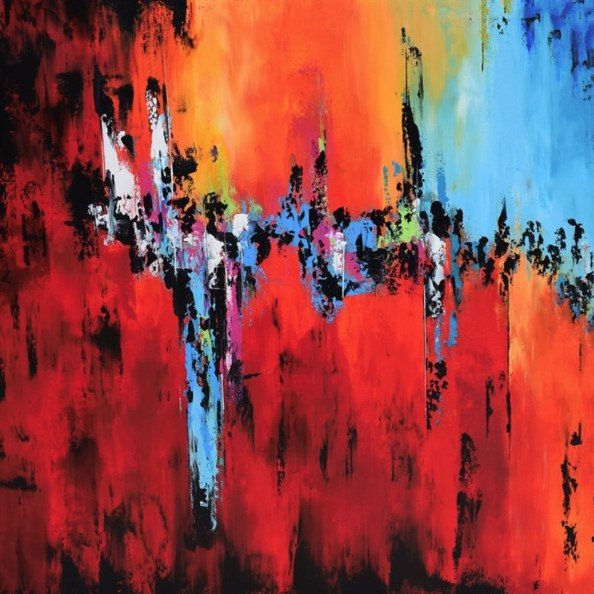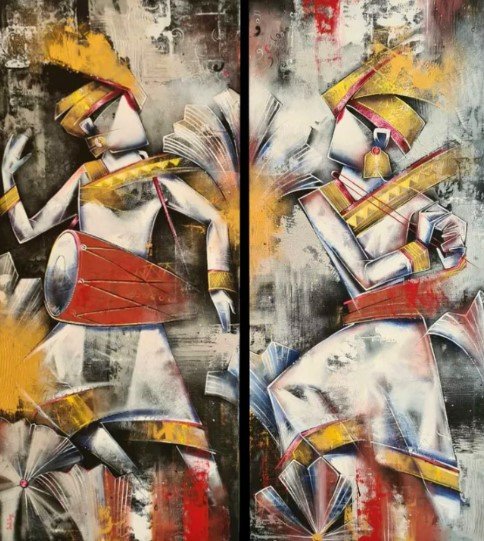10 Major Painting Movements —From Realism to Abstract Paintings

1. Abstract Paintings
Abstract paintings are one of the most prominent painting styles that employ forms, colors, lines, and textures to evoke feelings and visual effects rather than trying to depict reality. Early 20th-century abstract paintings evolved as a response to the naturalism and realism of earlier periods. Wassily Kandinsky, Piet Mondrian, and Kazimir Malevich were among the pioneers of abstract painting, experimenting with geometric, expressionist, and suprematist abstractions, among other styles. Abstract paintings created new avenues for artistic expression and questioned accepted ideas of what constitutes art.
Specialties of Abstract paintings
- Abstract paintings do not represent reality, but the artist’s vision.
- Diverse viewers may interpret them in different ways.
- They can evoke strong emotional reactions with colors and shapes.
- They can challenge the conventional notions of art and beauty.
- They also reflect the social, cultural, and historical context of their creation.

Buy this painting at Indianartzone.com
2. Modern & Contemporary Art
Modern art, which emerged in the late 19th and early 20th centuries, marked a departure from traditional artistic styles. Modern artists, rejecting classicism and realism, looked for new ways to express themselves. Impressionism, which focused on capturing light and fleeting moments, Expressionism, which highlighted emotion and interior experience, Cubism, which broke forms into geometric shapes, and Surrealism, which investigated the subconscious, are notable art styles. Modern art has left a lasting impression on visual culture with its vivid colors, abstract shapes, and disregard for convention. In the world of art, it is still a powerful and thought-provoking force.
Contemporary art has embraced innovation and challenged convention from the late 20th century to the present. It emerged after Pop Art and reinterprets popular culture and consumer goods as approachable works of art. Important movements include Conceptual Art, which prioritizes ideas above aesthetics, Minimalism, which emphasizes simplicity and geometric forms, and Abstract Expressionism, which is marked by emotional intensity and gestural brushwork. Contemporary art tackles societal themes, identity, and technology to reflect our rapidly evolving society. Its ability to elicit inquiry, participation, and interpretation from spectators makes it a dynamic force in the field of art.
Specialties of Modern & Contemporary Art
- Modern art is characterized by a break from the traditions of the past, such as realism, perspective, and proportion.
- Contemporary art is characterized by a focus on the concept, meaning, and context of the work, rather than the aesthetic appearance.
- Modern art experimented with new forms, techniques, and materials.
- Contemporary art often challenges the conventional notions of art, beauty, and value, and explores social, political, and cultural issues.

Buy this painting at Indianartzone.com
3. Portrait Paintings
Paintings that portray the likeness of an individual or group of individuals are known as portraits. These paintings typically feature the subject's face, expression, and personality. Since ancient times, portrait paintings have been a common genre in art, serving to portray the status, strength, and beauty of their subjects. Leonardo da Vinci, Rembrandt, Vincent van Gogh, and Frida Kahlo were among the most well-known portrait painters; they produced works of art that perfectly encapsulated the spirit and personality of their subjects. Painting portraits is an intriguing approach to investigating the diversity of civilizations and the human condition.
Specialties of Portrait paintings
- They capture the likeness and personality of a human subject, either by commission or by inspiration.
- They use various techniques, styles, and media to create different effects and expressions.
- Portrait paintings include symbolic elements that relate to the subject’s identity, story, or context.
- They serve as important historical, cultural, and artistic records.
- They influence the public perception and reputation of the subject.

Buy this painting at Indianartzone.com
4. Indian Paintings
Indian paintings are works of art that capture the rich and varied creative traditions of India, which stretch back thousands of years. Indian paintings draw inspiration from a multitude of religious traditions, including Buddhism, Jainism, Islam, and Hinduism, as well as geographical areas including Rajasthan, Mughal India, Bengal, and Kerala. Miniature paintings, which are tiny, intricate paintings that depict religious texts and court scenes; Madhubani paintings, which are vibrant, geometric paintings that depict folk tales and nature; and Tanjore paintings, which are gold-leaf paintings that represent Hindu gods and goddesses, are some of the most notable types of Indian paintings. Indian paintings are a vivid and distinctive way to represent Indian spirituality and culture.
Specialties of Indian paintings
- They use natural colors and materials, such as vegetable dyes, minerals, and plant extracts.
- It depicts various themes, such as nature, mythology, deities, festivals, social events, and court scenes.
- They have different styles and techniques, depending on the region, community, and period of origin.
- Indian paintings are often done on various surfaces, such as walls, cloth, paper, canvas, and wood.
- They have a unique aesthetic and symbolism, with geometric patterns, floral motifs, and expressive figures.

Buy this painting at Indianartzone.com
5. African Paintings
African paintings are works of art that capture the rich and varied creative traditions of the continent, which cut across numerous nations, regions, and ethnic groups. African paintings frequently employ symbolic and abstract elements to convey messages and meanings. They are affected by various issues, including politics, religion, history, and the environment. Among the most well-known African painting genres are Ndebele paintings, which are geometric and vibrant works of art that adorn the walls of Ndebele homes; Ethiopian paintings, which are religious and iconographic works of art that adorn the churches and manuscripts of the Ethiopian Orthodox Church; and contemporary African paintings, which are modern and innovative paintings that address various social and global issues. African paintings are a powerful and remarkable representation of the African identity and experience.
Specialties of African Paintings
- They frequently employ vivid hues, elaborate patterns, and a distinct spirituality.
- They reflect the cultural and traditional beliefs of the African people and their close relationship with nature.
- African Paintings exhibit originality and inventiveness, conventionalization, and visual abstraction, as well as a harmonious blend.

Buy this painting at Indianartzone.com
6. Hyper-Realistic Paintings
Paintings that use incredibly precise and detailed methods and materials to give the impression of reality are referred to as hyperrealistic paintings. The Hyper-realistic paintings emerged in the late 20th century as a response to the abstract and conceptual tendencies of earlier decades. Chuck Close, Richard Estes, and Alyssa Monks are among the most skilled hyperrealist painters. They employ a variety of techniques, including airbrushing, computer manipulation, and photography, to produce incredibly realistic portraits, landscapes, and still lifes. The Hyper-realistic paintings challenge the perception and interpretation of reality and art.
Specialties of Hyper-Realistic Paintings
- Hyper-realistic paintings use photographic images as a reference source.
- They replicate advanced techniques such as shading, lighting, perspective, and focus to create a false reality that simulates the human vision.
- They challenge the viewers to question their perception of reality and art.
Buy this painting at Indianartzone.com
7. Landscape Paintings
Paintings of the earth's natural landscape, including mountains, forests, rivers, and seas, are known as landscape paintings. Since the Renaissance, landscape paintings have been a popular form of art that aims to capture the essence, beauty, and spirit of the natural world. Claude Monet, J.M.W. Turner, and Georgia O'Keeffe were among the most prominent landscape painters. They experimented with various genres, including impressionism, romanticism, and modernism, to capture the light, color, and movement of nature. Landscape Paintings are a fascinating and motivating method to examine how people interact with the natural world.
Specialties of Landscape Paintings
- They can show different perspectives, such as near, middle, and far, to create a sense of depth and space.
- It may employ color, shape, and light to convey the feelings, ideas, and moods of the artist.
- Landscape Paintings can capture the beauty, diversity, and complexity of nature in various seasons, times, and locations.
- They can stand for a variety of artistic movements and styles, including expressionism, surrealism, romanticism, impressionism, post-impressionism, realism, and modern methods.

Buy this painting at Indianartzone.com
8. Cityscape Paintings
Paintings known as "cityscapes" feature elements of urban landscapes, including streets, buildings, bridges, and monuments. Since the 17th century, cityscape paintings have been a prominent genre in art, and they have been used to depict the history, culture, and identity of cities. Canaletto, Edward Hopper, and David Hockney are some of the remarkable cityscape painters who are renowned for their accurate, expressive, and vibrant depictions of cities like Venice, New York, and Los Angeles. Cityscape Paintings are one of the captivating and engaging methods to examine the richness and diversity of urban life.
Specialties of Cityscape Paintings
- They can convey the distinct vibe and features of many cities, including their geography, history, culture, and architecture.
- They show how urban life has evolved, including how globalization, industrialization, and modernization have affected it.
- Cityscape Paintings express the artists’ impressions, emotions, and perspectives on the cities they portray, using various styles, techniques, and colors.
- It can be realistic or abstract, depending on the artists’ intentions and preferences.

Buy this painting at Indianartzone.com
9. Nature and Scenery Paintings
Nature and scenery paintings are paintings that depict the natural elements of the earth, such as animals, plants, flowers, and rocks. Since ancient times, landscape and nature paintings have been widely employed as a means of showcasing the harmony, diversity, and beauty of the natural world. Among the most well-known landscape and nature artists were Albrecht Dürer, Henri Rousseau, and Robert Bateman. They produced vivid, inventive, and accurate depictions of various aspects of nature, including birds, rainforests, and wildlife. Paintings of scenery and nature are a fun and calming way to enjoy the mysteries and beauty of the natural world.
Specialties of Nature and Scenery Paintings
- Nature often symbolizes emotions, life cycles, or spiritual connections.
- Nature paintings evoke the mood, light, and ambiance of a specific place or time.
- Artists celebrate the awe-inspiring beauty of mountains, oceans, and sunsets.
- The minute details of nature, from leaves to river reflections, are well depicted.
- Nature paintings harmonize elements for visual appeal

Buy this painting at Indianartzone.com
10. Still Life Paintings
Paintings of inanimate objects including fruits, flowers, utensils, and books are known as still-life paintings. Since the 16th century, still life paintings have been a well-liked kind of art that showcases the artist's technique, aesthetic, and meaning. Caravaggio, Paul Cézanne, and Vincent van Gogh were among the most well-known still-life painters. They composed still-life elements like apples, sunflowers, and baskets in dramatic, inventive, and expressive ways. Still-life painting is an easy and sophisticated approach to investigating the beauty and significance of ordinary life.
Specialties of Still-life Paintings
- Still-life paintings often carry hidden meanings through the objects portrayed.
- The arrangement, lighting, and color evoke different emotions and introspection.
- Still-life paintings date back to ancient Rome and remain popular even in the twenty-first century.

Buy this painting at Indianartzone.com

